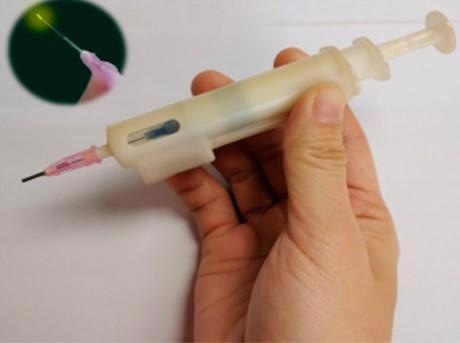Feb 12 2021
Certain colorless, odorless, and tasteless gases, such as nerve agents, can be toxic or even lethal if humans are exposed to them. The potential to detect vapors of other kinds could prevent people from eating rotten or spoiled food.
 The handy pen’s tip changes color when exposed to harmful gases. Adapted from ACS Materials Letters, 2021, DOI: 10.1021/acsmaterialslett.0c00516.
The handy pen’s tip changes color when exposed to harmful gases. Adapted from ACS Materials Letters, 2021, DOI: 10.1021/acsmaterialslett.0c00516.
Therefore, user-friendly, portable devices could be very useful in safeguarding the public. Scientists have now developed a pen-like sensor that changes in color upon exposure to hazardous gases. The findings of the study have been described in ACS Materials Letters.
Humans lack the ability to detect various toxic vapors, like poisonous nerve agents or volatile amines emanating from spoiled foods. Thus, a sensor with the ability to detect the very minute concentrations of these gases would be valuable. Fluorescence-based sensors are a promising solution as they are cost-effective and can indicate trace amounts of compounds.
But some fluorescing compounds tend to bind together when they react with gases, which reduces their intensity, and they can necessitate complex fabrication processes. However, other fluorophores synthesize more intense light upon binding together—aggregation-induced emission fluorogens (AIEgens).
A majority of the existing detection methods based on AIEgens are liquid-based and require gases to be dissolved in solution prior to analysis, and hence are not easily portable. Therefore, Zhe Jiao, Pengfei Zhang, Haitao Feng, Ben Zhong Tang, and colleagues intended to adapt AIEgens to be combined into a needle-thin fiber, thus developing a handheld device with a tip that “turns on” when a particular gas is present.
The researchers created two AIEgen-based “handy pens,” one for detecting the nerve agent diethyl chlorophosphite (DCP) and the other one for amines synthesized by rotting food. Initially, silicon dioxide polymer fibers were coated with a thin sol-gel layer to immobilize AIEgens. They then added an AIEgen that changes in color upon reacting with DCP on one set of fibers, and an AIEgen that reacts with amines on another set.
Then, the coated fibers were positioned at the end of a pen-like device equipped with a UV light source. The tip of the DCP sensor changed from a yellow fluorescence to blue in just 30 minutes of exposure to DCP. The tip of the amine sensor was first mild blue-gray in color but produced a vibrant yellow-colored light in just 5 minutes upon exposure to volatile amine vapors.
Both sensors returned to the original hue upon exposure to neutralizing vapors, which shows that they were reversible. Lastly, the amine-responsive handy pen was used to differentiate between a salmon sample that had been refrigerated and one that had been maintained at room temperature for 48 hours.
According to the researchers, other handy pens could be easily created with different vapor-sensitive AIEgens, which could be used for environmental monitoring, food safety, or public safety applications.
This study was financially supported by the Science and Technology Planning Project of Guangdong Province of China, Educational Commission of Guangdong Province of China, the Social Science and Technology Development Project of Dongguan, Guangdong International Cooperation Project, the Science and Technology Plan of Shenzhen, the UNSW-CAS Collaborative Research Seed Fund Program, and the Shenzhen Institute of Advanced Technology Innovation Program for Excellent Young Researchers.
Journal Reference:
Huang, X., et al. (2020) Development of Reaction-Based AIE Handy Pen for Visual Detection of Toxic Vapors. ACS Materials Letters. doi.org/10.1021/acsmaterialslett.0c00516.